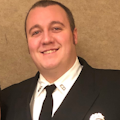The fire service responds to various emergencies, including fires, motor vehicle accidents, emergency medical calls and a multitude of technical rescue scenarios. Because of this, our personnel wear multiple hats at any given time, which allows them to mitigate each scenario as it presents itself. When we put on our fire-based EMS hat, the response can become even more diverse and complicated, particularly in rural departments.
Whether career, combination or volunteer department, limited manpower and/or limited resources can be a large factor that affects fire-based EMS. Typically, urban/suburban departments have the financial capability to support increased manpower, whereas rural departments struggle because of a lack of funds. This issue simply boils down to population and tax revenue. Luckily, many rural fire departments have adjusted and overcome this obstacle with ingenuity and have found great success.
My career department, the Central Fire District in Smithville, OH, is a prime example of fire-based EMS in the rural setting. We cover 52 square miles, which includes the village of Smithville and the majority of two townships. Our population is roughly 10,000 with a call volume of approximately 900 alarms per year. We provide service with 5 full-time and 14 part-time/volunteer members. The firehouse is staffed 24/7 with a minimum of two cross-trained personnel. Thankfully, our daytime staffing is upward of four personnel throughout the week. We rely heavily on our part-time/volunteer members when an incident is more involved. We operate three ALS medic units, two engines, two tenders, one aerial and a brush unit. As with most combination departments across the country, our run volume primarily is EMS-related.
Rural vs. metropolitan
Throughout my career, I’ve been blessed to network with an extraordinary group of firefighters from around the country. This has allowed me to get a good grasp of how other departments prioritize their fire-based EMS systems. I’ve found that although many departments operate fairly similar to what I’m used to, others don’t.
One major difference that I noted is that larger, city-based departments have dedicated, specialty-specific units, which allow fewer hats to be worn at any given time. For example, a metropolitan department might dispatch medic units, a truck company, a heavy rescue unit and, more than likely, a battalion chief or supervisor to a motor vehicle accident response. The medic units focus on patient care, the truck and rescue units focus on extrication/hazmat, and the battalion chief/supervisor is free to assume command and potentially serve in a safety
officer role. The rural reality is that a medic unit might or might not get an engine crew that has hydraulic tools on the road, let alone much other help. However, there are a handful of ways that rural fire-based EMS departments combat this problem.
Improvise
Something that I’ve grown accustomed to is carrying hydraulic equipment on the medic unit. From time to time, we respond to a motor vehicle accident with entrapment as a lone medic unit without an engine on the road. If this happens to you, you should call for an engine backup from your department and call for mutual aid, but you also should go to work with the resources that you have at hand. Even a two-person medic unit can assume patient care and begin extrication by dividing and conquering the situation. This isn’t an ideal situation, but it allows for the job to get done. You’ll be ever so thankful for that engine crew’s arrival after you popped the door and the patient is ready to be boarded and moved to the medic. Many hands make light work, but few hands can get the job done as well.
Rescue companies are few and far between in the rural community. Specialty rescue teams are even more scarce. To combat these issues, we added other rescue equipment to our medic units. Currently, we carry a plethora of water/ice rescue equipment, which includes Mustang suits, flotation devices, a hefty quantity of throw bags and rope, ice awes and other miscellaneous tools. Carrying this equipment allows us to get a medic unit out of the door with the equipment that we need for a water/ice rescue. It allows the crew to again divide and conquer. As the driver focuses on getting safely to the scene, the other member(s) can focus on getting into their Mustang suit in the back of the rig. This way, once the rescue concludes, a medic unit already is there and waiting to transport the patient.
Regardless of department size or coverage area demographics, we all have the same job. Our ultimate goal is to mitigate the incident to the best of our abilities and return home safely to our loved ones at the end of our shift. Whether hands are plentiful or scarce on an incident scene, the job always will remain the same. Use what resources that you have available to you, but remember, at times, you might need to improvise.
About the Author
Thomas Gross
Thomas Gross is a firefighter/paramedic with the Central Fire District in Smithville, OH. He holds Firefighter 2, paramedic, fire instructor and EMS instructor certifications.

